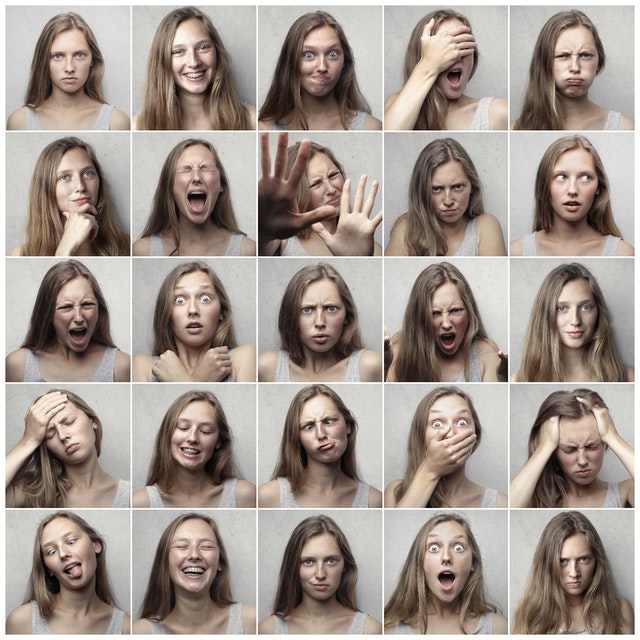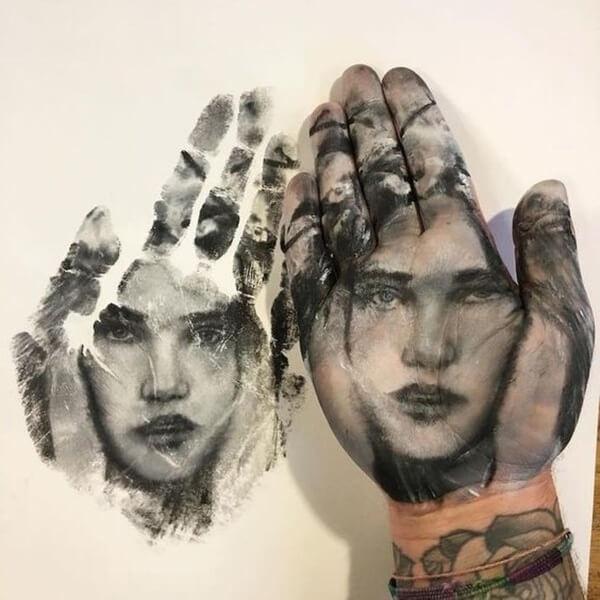Psychology of facial expressions and gestures: examples and facts. How to learn to understand people based on their gestures and facial expressions? The psychology of facial expressions and gestures provides an answer to this question.
Having studied and understood this topic, you can ensure that there are no secrets and hidden meanings in conversations with others and learn to read people like an open book.
Do you agree that the ability is very useful?
What is the psychology of facial expressions and gestures?

Facial expressions and gestures in communication with others play a huge role. They help to enhance, fully reveal feelings. With the help of facial expressions, we express emotions that we are not talking about. Our body is very insidious, we may not notice how we say one thing, and body language shows something completely different.
Without noticing it, we give out our hidden intentions and unsaid words. Our body is more eloquent than any speeches and tirades.
It will be difficult for an inexperienced person to figure out where and how his interlocutor cheated. But those who are familiar with the topic of facial expressions and gestures are provided with an understanding of the situation and the ability to take control of it.
Facial expressions and gestures are very strongly intertwined with each other, so they are always considered in one bundle.
“The one who lies in the language of words betrays himself in the language of signs, which he does not pay attention to.”
Oswald Spengler
We will do the same and in this article, we will answer the most common questions on the topic of facial expressions and gestures.
Human facial expressions and gestures, psychology of influence! Read it, it will be interesting 😉
Terms and concepts of the section of facial expressions and gestures
Gesture refrain, dictionary of psychoanatomy symbolism, ergonomics of gestures. What it is?
These phrases are difficult to comprehend for people who first encountered the topic of gestures and facial expressions. Simply put, these are the components of this section of psychology, which make it possible to understand facial expressions and gestures at a more detailed level than “his ears are burning, so he is lying.” Everything is much deeper and more serious than it might seem at first glance.
A gesture refrain is a repetitive gesture that always has the same meaning.
Here’s an example. Crossed arms. If the right is on top of the left, it is resentment. If on the contrary – a defensive position.
The Dictionary of Symbolic Psychoanatomy is a kind of deciphering of sign language. Based on it, you can find out what certain gestures mean in the current situation. This section is considered purely on specific examples since, in different situations, the same gesture can be interpreted in different ways. The ergonomics of facial expressions and gestures is a section that describes the ability to adapt body language to specific tasks. For example, to influence the human psyche with the help of positive beliefs transmitted through gestures.
Learning the ergonomics of gestures is a great way to communicate more productively and effectively. It makes it possible to influence a person with gestures and facial expressions, which subconsciously evoke positive emotions in that person.

Fraudsters take advantage of this. For example, in order to endear a person to himself, a fraudster may touch his hand while telling an anecdote or some pleasant and funny story. Thus, the human brain begins to respond positively to this gesture.
Then, when it comes to “turning” the scam itself, the fraudster accidentally touches the person’s hand again, awakening relaxation and positiveness in his mind. This makes it easier to commit fraud because a relaxed person will not begin to suspect something. His brain has been deceived by psychology.
What gives an understanding of facial expressions and gestures?
A shortlist of benefits:
- Active work of the brain.
You need to memorize a bunch of gestures and movements that indicate some specific meaning. For example, if during a dialogue the interlocutor scratches the back of his head, this means that he is not sure of your words and gives in to doubt. There are many such examples, and most of them must be constantly kept in mind.
- Ability to adapt and change the situation.
When you know more than what you are told, you can often find the right solutions in various situations, lead the interlocutor to something or get answers where he does not even say them.
- Understanding a person’s negative motivations.
Knowledge of this topic will allow you to protect yourself from lies, envy, unfriendliness, etc.
- Understanding the inner world of the interlocutor.
The correct interpretation of facial expressions and gestures not only makes it possible to look into the soul, finding out all the secrets of the interlocutor but also to understand that he needs help, although he is trying to hide it. In this case, you can try to find the right words and try to figure out the problem together.
- Developing the ability to notice the smallest details.
Without this ability, it is impossible to interpret the prevailing picture of facial expressions and gestures. One unnoticed gesture can drastically change the whole meaning of the signals given by the body. Therefore, if we want to correctly interpret the body language of another person, we need to be more attentive and receptive to little things.

- Self-development.
Self-development is a bonus when studying the psychology of facial expressions and gestures. A person learns to know both himself and others, studies something deep, draws something useful for himself.
Where to start learning the language of facial expressions and gestures?
Consider all sources of knowledge on the psychology of facial expressions and gestures:
- Literature.
The first assistant in the study of this topic. In addition to printed books, many specialists in this section of psychology publish magazines, open websites, and blog on the Internet.
- Courses for the study of the psychology of facial expressions and gestures.
A person who understands the topic will be able to personally show and explain how everything works and how to apply the knowledge gained in life.
- Watching TV series or documentaries on this topic.
Oddly enough, a very large amount of information can be gleaned from there. Plus, everything is shown therein practice, which greatly simplifies understanding and mastering the “lessons” in the head.
- Practice.
Reading and watching are, of course, good, but it is necessary to apply the knowledge gained in real conditions. This is the only way to assimilate information and change something in your life.
The meaning of gestures and facial expressions on specific examples
Theoretical knowledge should be considered in specific, simulated situations. This is the only way to correctly understand what the interlocutor is “silent” about. Let us analyze how the feelings of the interlocutor are connected with the movements of various parts of his body.
Lips
Overconfidence is most often associated with lip mobility.

Example 1.
The interlocutor, leaning his elbow on the armrest of the chair, strokes his lips with his index finger, while not making a single sound.
This means that the person is confused and does not know what decision to make. The interlocutor thinks that they are trying to manipulate, and his gesture is tantamount to uncertainty. This example is not frequent, but very eloquent.
Example 2.
The hermetically compressed lips of the interlocutor completely ceased to be visible.

There are two options here:
- This shows a person as a virtue, quite experienced, wise.
- Disgust. Moreover, it is close to complete rejection. This is the more common option.
In this case, the context of the conversation is important. If during a conversation you mentioned something unpleasant or touched a topic that is painful for the interlocutor, then this can be seen by his compressed lips. In this case, it is worth taking the conversation aside and changing the topic to a neutral one.
Example 3.
The interlocutor bites the upper or lower lip.
This means a person’s dissatisfaction. Perhaps the person you are talking to is exhausted and emotionally overwhelmed. If a woman bites her upper lip, she, as a rule, is afraid of something.
Also, this gesture can be considered as seduction, then it indicates arousal of love.
Back
The back is the center of sensuality, also responsible for the ability to put maximum effort into something.

Example 1.
The interlocutor gave his comrade a friendly slap on the back.
This is a direct expression of sympathy or just a good mood. It is said to be an abbreviated version of a hug.
It is worth noting that this gesture does not always mean something good. Read the part of the article on gesture ergonomics.
Example 2.
The interlocutor communicates with you with his back turned.
If men take this position, this indicates their inability to make decisions. It also indicates a lack of leadership qualities, because the one to whom they are inherent will openly meet any turn of the situation and resolve issues, being face to the interlocutors.
Brushes
The brushes are the most active and mobile part of the body, they can tell a lot.
Example 1.
If your interlocutor holds his hands in a “prayer” position, then this means an implacable gesture rather than a condescending one. You should be prepared for the interlocutor to object to what you said.
Example 2.
The interlocutor closes his hand as if holding something small in it.
This gesture means that a person only takes, not gives. This is a symbol of selfishness.
Jaw
The jaw is associated with anger in all its negative forms.
Example 1.
Does it happen that a person begins to grind his teeth in the middle of the night? So, this is not a habit or a feature of the body, it is nothing more than anger. Most often, a person who has experienced a very spiteful and gloomy situation during the day involuntarily manifests this at night through a dream.
Example 2.
The interlocutor’s jaws are constantly in a hidden chewing process. This indicates a very changeable personality.
Example 3.
The nodules seem to pulsate under the skin, and tears are about to flow from the eyes. This is a sign that the interlocutor is clearly losing his composure, he is very shaken by something and keeps emotions in himself with the last bit of strength.
In the article, we consider only the main examples, in addition to them, the psychology of facial expressions and gestures analyzes many situations and contexts.
Thanks to this knowledge, everyone has the opportunity to feel the essence of the behavior of their interlocutor, to understand what he actually experiences and feels.
Regrettably, people tend to lie, hide something, or under-speak. The psychology of facial expressions and gestures will help shed light and clarity on many situations, such serious knowledge can save you from trouble.
How to use knowledge about facial expressions and gestures?
You can use this knowledge very actively.
- If it was noticed from certain gestures or facial expressions that the interlocutor does not want to continue the conversation, you can tactfully end the conversation and leave.
- Observing how a new acquaintance is cunning or hiding the truth, you can remove such a person from the social circle, depriving yourself of eternal secrets and omissions.
- You can be saved from deceivers.
Professional liars and manipulators are well versed in psychology. To hide the secret manifestations of facial expressions or gestures, they learn to control the smallest movements.
They are hard, but still possible to see through. It is enough to observe their behavior for a while, somewhere their body will fail and then everything will become apparent.
Tip : If you are not sure about the truthfulness of a person’s speech, ask him more questions and observe his body movements.
Such deep knowledge makes it possible to see the true face of people. Not everyone is who they say they are. So why not “split” the person before he could do something not very pleasant in your direction.
- On the positive side, the ability to use gestures and facial expressions can subconsciously win over a person to you, relax him and make him very accommodating.
You will be able to positively influence him, his well-being. So why not endow a person’s emotions with positive, using facial expressions and gestures?
Psychology of facial expressions and gestures in society
Knowledge and facial expressions and gestures are widely used in investigations and investigations.
When interrogating a suspect or witness, a specialist can track certain facial characteristics, by which it is easy to calculate whether a person is lying or telling the truth. Our body will not let itself be deceived. A person can, without suspecting it, betray himself through gestures and facial expressions.

Interesting Facts
- There is an interesting way to find out if a person is lying: you need to shake his hand. If he lies, it will be cold, because when a person lies, the body understands this and takes action. The blood goes down to the legs, so that in case of something – to run as fast as possible.
- A sincere smile lasts no more than four seconds. Moreover, wrinkles around the eyes are an additional factor of sincerity. If a person “pulls” a smile, then the facial expressions of the eyes will not be affected.
- If a man, during a conversation with a woman, turned his leg toe in her direction, this means that he is sympathetic. This is a great way for girls to screen young people for interest in them.
- Itching. Oddly enough, itching can tell you a lot, you just have to pay attention to where it occurs. Is the back of your head itchy? This indicates self-doubt. If this is the chin, then the subconscious mind pushes the person to challenge. If the itching started in the area of the back of the left hand, you need to “close”. Right hand (also the backside) – the subconscious mind says that you need to cheat.
- In some cases, facial expressions, gestures of men have a completely different meaning than the same facial expressions and gestures of women.
Conclusion
The psychology of facial expressions and gestures is not an easy topic to study and master. But how interesting and exciting it is! Just think, interpreting simple elements of behavior helps to literally read a person like a book. This is a very valuable ability.
Read Also: Placebo Effect in Psychology and Medicine

